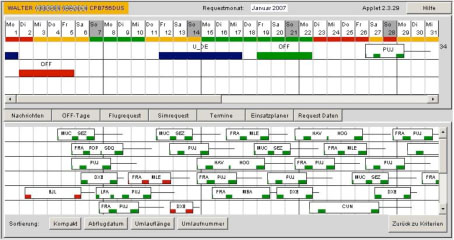CONDOR

Condor serves 81 destinations and operates 50 aircraft (2021).
Condor has been using CRS/Condor, a crew request system provided by Kernel Software, since 2000. In 2008, it replaced most components of its crew management system, but elected to retain CRS/Condor.
CRS/Condor enables Condor crew-members to submit requests for their monthly OFF block (*) and for up to three rotations (**). As the crew request (or “preferential bidding”) systems of other airlines, it checks whether the requests are legal (***), and, when there are too many requests for the same rotation or for the OFF block on the same date, it selects which requests must be granted and which ones must be denied (****).
What makes CRS/Condor stand out among other request systems is that it is a real-time request system. In other words, it does not simply record requests until a monthly batch job decides whether they are granted or denied, in the meantime leaving the requesting crew-members without any clue about the final decision. CRS/Condor is a real-time request system because, as soon as a request is submitted, it immediately tells the submitting crew-member whether his request is granted, and also immediately evaluates the impact of granting the new request on the existing requests.
Now, granting the request of a crew-member often means denying the request of another crew-member (one with a lower “priority”, as defined by the airline’s fairness rule). Since a crew-member can define alternative requests in case his first-choice request is denied, and since granting an alternative request can in turn cause the request of a third crew-member to be denied, the submission of a single request can have an impact on many other requests, very much in the same way as a single ball hitting a tight cluster of balls starts a chaotic chain reaction. CRS/Condor is a real-time request system because it is capable of recalculating in a fraction of a second the status of all requests whenever a given one is added or deleted. It works as a stock exchange that constantly recalculates the value of company shares, the difference being that a real-time crew request system is not a market for stocks but for rotations and OFF blocks.
As a result, CRS/Condor enables Condor crew-members to submit requests which will actually be granted, and removes the inconvenience of submitting requests only to find out, weeks later, that they have been denied.
(*) An OFF block is a sequence of 4 consecutive days of rest on which a crew-member cannot be called for work (typically, a crew-member has 10 or 11 rest days per month, but the exact dates of the rest days which are not in the OFF block can be changed on short notice).(**) A rotation is a sequence of flights starting from a so-called base airport and returning to this airport. When the flights are long range (intercontinental) flights, a rotation is simply a round trip. However, short-range rotations frequently include more than 10 flights. Rotations are the building blocks of the crew-members’ schedules, which are called rosters.
(***) The roster (schedule) of a crew-member must obey an amazing number of complex labor rules. For instance, a request is “illegal” if the requested rotation starts shortly after the end of the preceding rotation, thus leaving too short a rest period.
(****) The decision to grant or deny a request is based on so-called fairness rules which take into account a variety of factors, such as the seniority of the crew-member, or how recently he flew to the destination of the requested rotation.
In practice, when a crew-member wants to submit a rotation request, he first needs to know where the rotations are going (flying to exotic places is often the reason why ones chooses to work for an airline) and when they return (each rotation is followed by a rest period that can extend over several days which sometimes correspond to the dates on which a crew-member would like to be off-duty). CRS/Condor supports a very simple, yet very powerful query feature that enables crew-members to find out which rotations correspond to their wishes and to their aircraft qualifications.
Additionally, CRS/Condor supports a unique additional feature: when it shows a rotation to a crew-member, CRS/Condor has already evaluated whether the crew-member has enough “priority” to get it. If not, the rotation is red; there is no point in requesting it. If the rotations still has open positions, it is green. Finally, if all positions of the rotation are already requested, but if the crew-member has enough priority to use a position already granted to a colleague, the rotation is orange.






